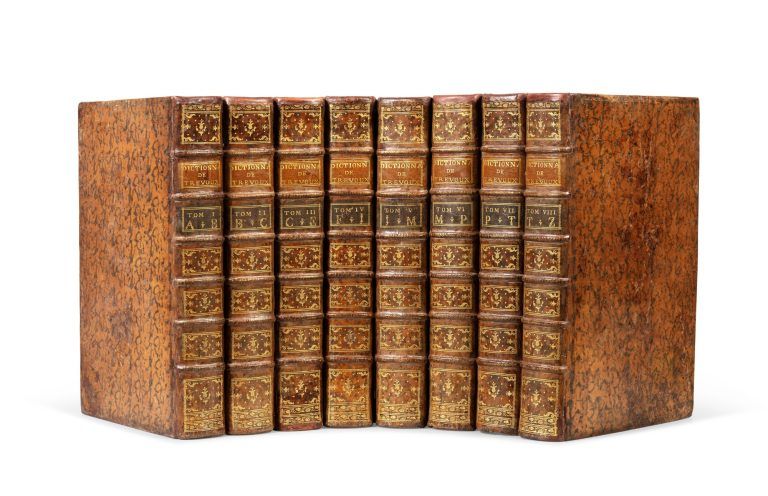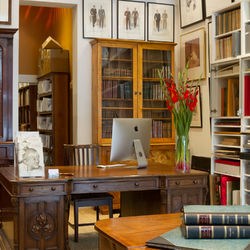
| Buy via BIBLIO |
Paris : Compagnie des Libraires Associés, 1771. Eight volumes, folio (400 x 255 mm), uniform contemporary marbled calf, spines with raised bands decorated in gilt and contrasting title and volume pieces stamped in gilt; edges stained red; original marbled endpapers; title leaves in red and black; engraved headpieces and decorative initials; text in double-columns, printed on wide-margined paper; contents crisp and clean throughout (some occasional and very light spotting); marginal tear to one leaf in second volume; bindings with occasional scuffing or scratches, headcaps expertly restored, cracked joints (some repaired). The final and most comprehensive edition of this famous dictionary. 'Nouvelle édition corrigée et considérablement augmentée […] contenant la Signification & la Définition tant de l’une et de l’autre Langue avec leurs différents usages, que des termes propres de chaque Etat & de chaque Profession ; la Description de toutes les choses naturelles et artificielles ; leurs figures, leurs espèces, leurs propriétés : L’Explication de tout ce que renferment les Sciences & les Arts, soit libéraux, soit méchaniques, &c.' [New corrected and considerably enlarged edition […] containing the Meaning & Definition both of one and the other Language with their different uses, and of the proper terms of each State & each Profession; the Description of all things natural and artificial; their figures, their species, their properties: The Explanation of all that the Sciences and the Arts contain, whether liberal, whether mechanical, &c.]. Originally a competitor to that of Furetière (1690), the Trévoux dictionary was so-called because it was first published in Trévoux, near Lyon, in 1704. This town was situated in The Dombes, an independent municipality whose relaxed regulations attracted booksellers and printers who might otherwise have feared censorship. A second edition was printed in Trévoux in 1721, but the several subsequent editions were published in either Nancy or Paris. Its authors, mainly Jesuit fathers, continued to revise and augment each successive edition, incorporating a large number of their sources and thus creating a true synthesis of the standard lexicographical works of the 16th and 17th centuries. The Trévoux dictionary was a major inspiration for Ephraim Chambers' Cyclopaedia (1728), as well as for Diderot's Encyclopédie, ou dictionnaire raisonné des sciences, des arts et des métiers (1751-72), one of the most important publishing achievements of the Enlightenment.
Offered by Douglas Stewart Fine Books
Douglas Stewart Fine Books






